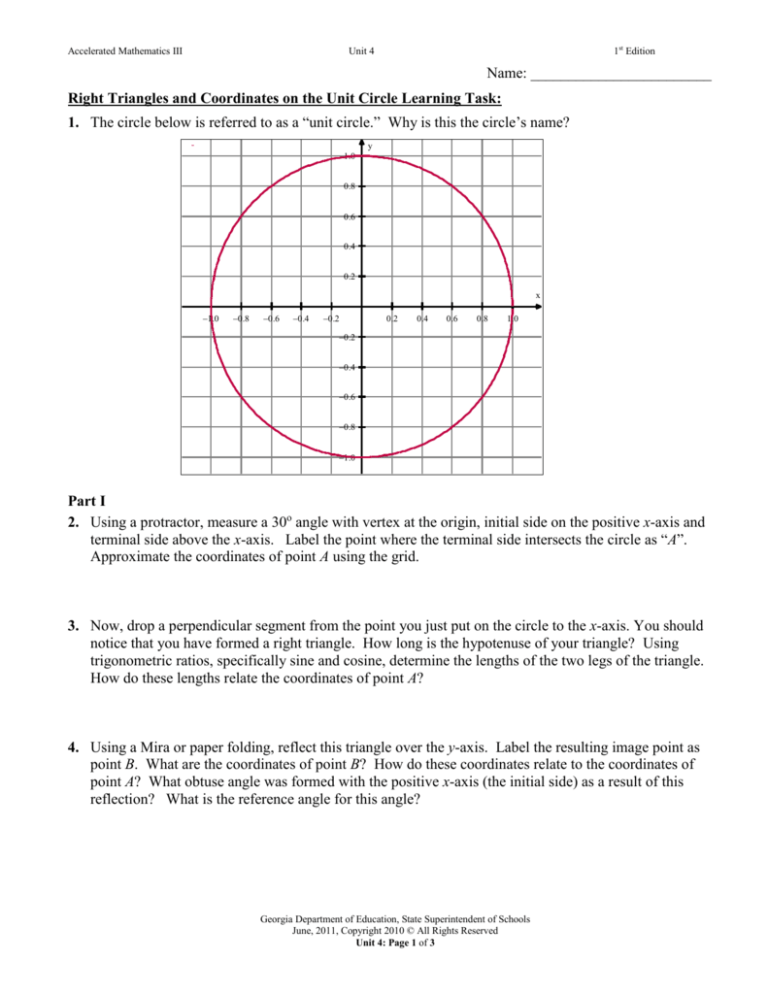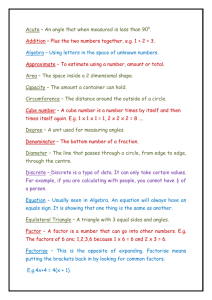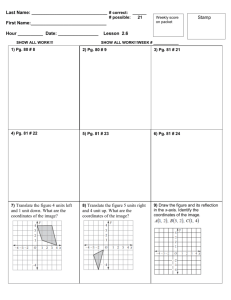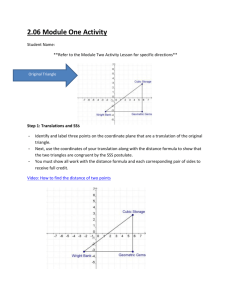
Accelerated Mathematics III
1st Edition
Unit 4
Name: ________________________
Right Triangles and Coordinates on the Unit Circle Learning Task:
1. The circle below is referred to as a “unit circle.” Why is this the circle’s name?
y
x
Part I
2. Using a protractor, measure a 30o angle with vertex at the origin, initial side on the positive x-axis and
terminal side above the x-axis. Label the point where the terminal side intersects the circle as “A”.
Approximate the coordinates of point A using the grid.
3. Now, drop a perpendicular segment from the point you just put on the circle to the x-axis. You should
notice that you have formed a right triangle. How long is the hypotenuse of your triangle? Using
trigonometric ratios, specifically sine and cosine, determine the lengths of the two legs of the triangle.
How do these lengths relate the coordinates of point A?
4. Using a Mira or paper folding, reflect this triangle over the y-axis. Label the resulting image point as
point B. What are the coordinates of point B? How do these coordinates relate to the coordinates of
point A? What obtuse angle was formed with the positive x-axis (the initial side) as a result of this
reflection? What is the reference angle for this angle?
Georgia Department of Education, State Superintendent of Schools
June, 2011, Copyright 2010 © All Rights Reserved
Unit 4: Page 1 of 3
Accelerated Mathematics III
1st Edition
Unit 4
5. Which of your two triangles can be reflected to create the triangle in the third quadrant with a 30o
reference angle? What is this angle measure (from the original initial side and counter-clockwise)?
Complete this reflection. Mark the lengths of the three legs of the third quadrant triangle on your graph.
What are the coordinates of the new point on circle? Label the point C.
6. Reflect the triangle in the first quadrant over the x-axis. What is this angle measure? Complete this
reflection. Mark the lengths of the three legs of the triangle formed in quadrant four on your graph.
What are the coordinates of the new point on circle? Label this point D.
7. Let’s look at what you know so far about coordinates on the unit circle. Complete the table.
x-coordinate
y-coordinate
Notice that all of your angles so far have a reference angle of 30o.
Part II
8. Now, let’s look at the angles on the unit circle that have 45o reference angles. What are these
angle measures?
9. Mark the first quadrant angle from #8 on the unit circle. Draw the corresponding right triangle as
you did in Part I. What type of triangle is this? Use the Pythagorean Theorem (or special right
triangle formulae) to determine the lengths of the legs of the triangle. Confirm that these lengths
match the coordinates of the point where the terminal side of the 45o angle intersects the unit circle
using the grid on your graph of the unit circle.
10. Using the process from Part I, draw the right triangle for each of the angles you listed in #8.
Determine the lengths of each leg and match each length to the corresponding x- or y-coordinate
on the unit circle. List the coordinates on the circle for each of these angles in the table.
x-coordinate
y-coordinate
Georgia Department of Education, State Superintendent of Schools
June, 2011, Copyright 2010 © All Rights Reserved
Unit 4: Page 2 of 3
Accelerated Mathematics III
1st Edition
Unit 4
Part III
11. At this point, you should notice a pattern between the length of the horizontal leg of each triangle and
one of the coordinates on the unit circle. Which coordinate on the unit circle is given by the length of
the horizontal leg of the right triangles?
12. Which coordinate on the unit circle is given by the length of the vertical leg of the right triangles?
13. Is it necessary to draw all four of the triangles with the same reference angle to determine the
coordinates on the unit circle? What relationship(s) can you use to determine the coordinates instead?
14. Use your method from #13 to determine the (x, y) coordinates where each angle with a 60o reference
angle intersects the unit circle. Sketch each angle on the unit circle and clearly label the coordinates.
Record your answers in the table.
x-coordinate
y-coordinate
Part IV
15. There are a few angles for which we do not draw right triangles even though they are very important to
the study of the unit circle. These are the angles with terminal sides on the axes. What are these angles?
What are their coordinates on the unit circle?
x-coordinate
y-coordinate
Georgia Department of Education, State Superintendent of Schools
June, 2011, Copyright 2010 © All Rights Reserved
Unit 4: Page 3 of 3
Accelerated Mathematics III
1st Edition
Unit 4
y
x
Georgia Department of Education, State Superintendent of Schools
June, 2011, Copyright 2010 © All Rights Reserved
Unit 4: Page 4 of 3
Accelerated Mathematics III
Unit 4
1st Edition
Right Triangles and Coordinates on the Unit Circle Learning Task:
Students may complete the work for this task on the large unit circle provided under #1. Colored pencils
would be very helpful for the activity. You may want to make multiple copies of the unit circle graph so that
students can use a “clean” unit circle for each reference angle group.
1. The circle below is referred to as a “unit circle.” Why is this the circle’s name?
Part I
2. Using a protractor, measure a 30o angle with vertex at the origin, initial side on the positive x-axis and
terminal side above the x-axis. Label the point where the terminal side intersects the circle as “A”.
Approximate the coordinates of point A using the grid.
Students should use the grid to approximate the x and y coordinates of
A. These values should be close the answers shown, but may vay
slightly.
3. Now, drop a perpendicular segment from the point you just put on the circle to the x-axis. You should
notice that you have formed a right triangle. How long is the hypotenuse of your triangle? Using
trigonometric ratios, specifically sine and cosine, determine the lengths of the two legs of the triangle.
How do these lengths relate the coordinates of point A? How should these lengths relate to the
coordinates of point A?
The hypotenuse is 1 unit long.
y
Horizontal Leg: sin 30
y = 0.5
1
x
Vertical Leg: cos 30
x = 0.866
1
The values should be the same or similar to the
estimates from the graph in #2.
Georgia Department of Education, State Superintendent of Schools
June, 2011, Copyright 2010 © All Rights Reserved
Unit 4: Page 5 of 3
Accelerated Mathematics III
Unit 4
1st Edition
4. Using a Mira or paper folding, reflect this triangle across the y-axis. Label the resulting image point as
point B. What are the coordinates of point B? How do these coordinates relate to the coordinates of
point A? What obtuse angle was formed with the positive x-axis (the initial side) as a result of this
reflection? What is the reference angle for this angle?
The coordinates of B are (-0.866, 0.5). The x-values of A and B are opposites while the y-values are
the same. The angle of rotation formed is 150o. The reference angle is 30o.
5. Which of your two triangles can be reflected to create the angle in the third quadrant with a 30o
reference angle? What is this angle measure? Complete this reflection. Mark the lengths of the three
legs of the third quadrant triangle on your graph. What are the coordinates of the new point on circle?
Label the point C.
The triangle from #4 (corresponding to the 150o angle) can be reflected over the x-axis to create the
indicated angle. The resulting angle measures 210o.
6. Reflect the triangle in the first quadrant over the x-axis. What is this angle measure? Complete this
reflection. Mark the lengths of the three legs of the triangle formed in quadrant four on your graph.
What are the coordinates of the new point on circle? Label this point D.
The resulting positive angle, in standard position, is 330o.
Georgia Department of Education, State Superintendent of Schools
June, 2011, Copyright 2010 © All Rights Reserved
Unit 4: Page 6 of 3
Accelerated Mathematics III
1st Edition
Unit 4
7. Let’s look at what you know so far about coordinates on the unit circle. Complete the table.
30o
150o
210o
330o
x-coordinate
0.866
-0.866
-0.866
0.866
y-coordinate
0.5
0.5
-0.5
-0.5
Notice that all of your angles so far have a reference angle of 30o.
Part II
8. Now, let’s look at the angles on the unit circle that have 45o reference angles. What are these angle
measures?
The angles are 45o, 135o, 225o, 315o.
9. Mark the first quadrant angle from #8 on the unit circle. Draw the corresponding right triangle as you
did in Part I. What type of triangle is this? Use the Pythagorean Theorem to determine the lengths of
the legs of the triangle. Confirm that these lengths match the coordinates of the point where the terminal
side of the 45o angle intersects the unit circle using the grid on your graph of the unit circle.
This is an isosceles right triangle.
a2 a2 1
2a 2 1
1
2
1
a
0.7071
2
a2
Georgia Department of Education, State Superintendent of Schools
June, 2011, Copyright 2010 © All Rights Reserved
Unit 4: Page 7 of 3
Accelerated Mathematics III
1st Edition
Unit 4
10. Using the process from Part I, draw the right triangle for each of the angles you listed in #8. Determine
the lengths of each leg and match each length to the corresponding x- or y- coordinate on the unit circle.
List the coordinates on the circle for each of these angles in the table.
45o
135o
225o
315o
x-coordinate
0.7071
-0.7071
-0.7071
0.7071
y-coordinate
0.7071
0.7071
-0.7071
-0.7071
Part III
11. At this point, you should notice a pattern between the length of the horizontal leg of each triangle and
one of the coordinates on the unit circle. Which coordinate on the unit circle is given by the length of
the horizontal leg of the right triangles?
The length of the horizontal leg provides the x-value of the coordinate on the unit circle. The sign of
the coordinate is determined by the quadrant in which the angle lies. The x-coordinate is the cosine
of the angle on the unit circle.
12. Which coordinate on the unit circle is given by the length of the vertical leg of the right triangles?
The length of the vertical leg provides the y-value of the coordinate on the unit circle. The sign of
the coordinate is determined by the quadrant in which the angle lies. The y-coordinate is the sine of
the angle on the unit circle.
13. Is it necessary to draw all four of the triangles with the same reference angle to determine the
coordinates on the unit circle? What relationship(s) can you use to determine the coordinates instead?
It is helpful to draw the triangles, but it is not necessary. Students can use the patterns they have
found to this point to determine the coordinates on the unit circle.
Georgia Department of Education, State Superintendent of Schools
June, 2011, Copyright 2010 © All Rights Reserved
Unit 4: Page 8 of 3
Accelerated Mathematics III
1st Edition
Unit 4
14. Use your method from #13 to determine the (x, y) coordinates where each angle with a 60o reference
angle intersects the unit circle. Sketch each angle on the unit circle and clearly label the coordinates.
Record your answers in the table.
60o
120o
240o
300o
x-coordinate
0.5
-0.5
-0.5
0.5
y-coordinate
0.866
0.866
-0.866
-0.866
Part IV
15. There are a few angles for which we do not draw right triangles even though they are very important to
the study of the unit circle. These are the angles with terminal sides on the axes. What are these angles?
What are their coordinates on the unit circle?
0 , 360o
90o
180o
270o
o
x-coordinate
1
0
-1
0
y-coordinate
0
1
0
-1
Georgia Department of Education, State Superintendent of Schools
June, 2011, Copyright 2010 © All Rights Reserved
Unit 4: Page 9 of 3








